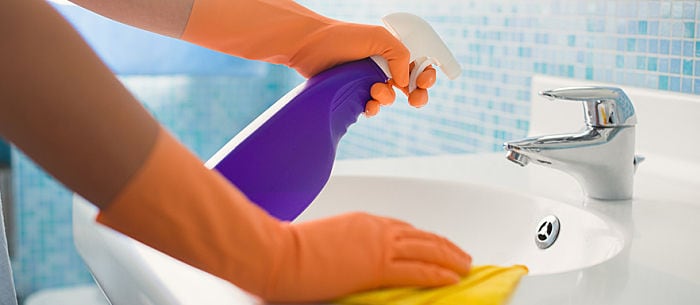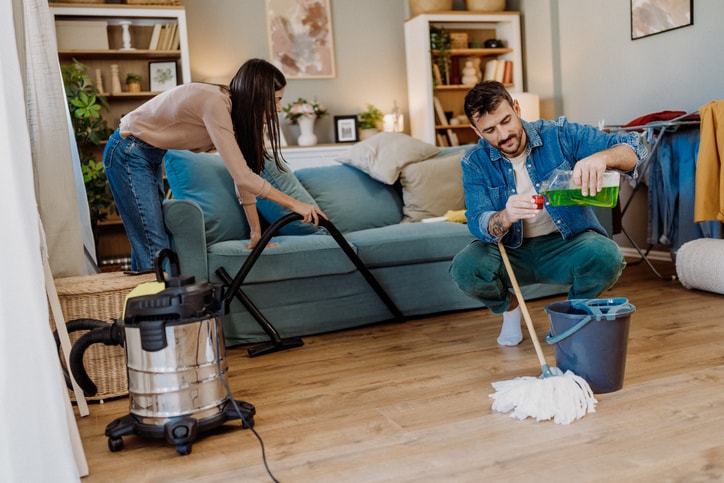Two words are about to solve a few of your top problems as a parent — natural disinfectant.
You spent the afternoon making the latest, greatest play dough recipe that Pinterest has to offer. Everything went great — until your tot licked the grime-covered kitchen counter. Ewww! Sure, spraying on a chemical cleaner gets those tummy-turning germs gone, but do you really want your 3-year-old licking something with a list of ingredients that look like they belong in a lab?
“Eliminating chemical-based products in your home is the safest choice for your family — no chemicals for little ones to get into and no chemicals on surfaces and in the air your family breathes,” says Becky Rapinchuk, the author of “The Organically Clean Home” and creator of the Clean Mama website.
What’s the solution? After all, some homemade disinfectants actually have chemicals in them (for example, alcohol or hydrogen peroxide) because disinfecting (killing viruses and bacteria) takes strength. That said, you don’t need mega-amounts of man-made ingredients to get the job done. Think green and check out these natural disinfectant products!
- Lemon Juice
Katie Schneider, the creator of the blog All Natural Katie, suggests mixing everyday ingredients that you may already have.”Homemade natural cleaning products can be easily and quickly made with products that you probably already have in your house. Ingredients like water, vinegar, baking soda, lemon juice and essential oils (optional) can be mixed together in various combinations to clean just about anything.” For a solution that’s strong enough to disinfect a grimy toilet, mix lemon juice and baking soda into a paste, like The Bearded Iris does.
- Hydrogen Peroxide
You already clean off your little guy’s scrapes and skinned knees with the stuff, so why not use it to clean your home as well? According to the U.S. Centers for Disease Control and Prevention, hydrogen peroxide can destroy some bacteria, viruses, spores, yeasts and fungi. Use a 3 percent formula, and allow it to sit on the surface for one full minute or longer.Keep in mind, hydrogen peroxide may stain or discolor some surfaces. Always test out this cleaner on a small (out of the way) patch before spraying it everywhere. Use The Yummy Life’s tip and screw a spray nozzle directly onto a hydrogen peroxide bottle for easy cleaning.
- White Vinegar
Rapinchuk suggests using this item that’s probably already in your kitchen cabinet for disinfecting. She notes, “My favorite all-natural ingredients for disinfecting are white vinegar, rubbing alcohol, hydrogen peroxide and vodka. When used properly, these household ingredients clean and disinfect just as well.” Make an all-purpose vinegar cleaner for your kitchen using this recipe from A Bowl Full of Lemons.
- Tea Tree Oil
Do you remember spotting this stuff on pimples during your adolescent days (or maybe in more recent times)? The oil isn’t just for skin, it’s also a natural disinfectant. Check out the Imperfect Homemaker’s non-toxic disinfectant spray if you’re looking for a tea tree oil-containing recipe.
- Ready-made Products
The labels says it’s “Good for the Earth,” but what does that mean? As the Environmental Protection Agency notes, safer (this doesn’t mean 100 percent safe or completely non-toxic) cleaning products should have certifications such as the EPA’s Design for the Environment, the Green Seal or the EcoLogo.Look for natural products that include germ-fighting ingredients such as citric or lactic acid. Products such as Better Life’s Clary Sage and Citrus All-Purpose Cleaner, Greenshield Organic Bathroom Cleaner and Seventh Generation Disinfectant Multi-Surface Cleaner all include natural ingredients. For kitchen messes, try natural soaps for disinfecting. “Adding natural liquid soaps like Dr. Bronner’s soap helps to degrease,” notes Schneider.
If you’re wondering whether natural cleaners really get the job done, Rapinchuk says, “I think that natural disinfectants work better than chemical-based products. There are no fumes, surfaces are cleaned and I can breathe the air while I’m cleaning.”
Always remember, these are still cleaning products and should never be left out where your young child could get a hold of them. If ingested, any disinfectant — including the natural ones — could cause health problems for you or your child.
To learn more about going au natural, read 7 Benefits of Green Cleaning.
Erica Loop is a mom, parenting writer and educator with an MS in child development. When she’s not teaching, she’s busy creating kids’ activities for her blog Mini Monets and Mommies.


